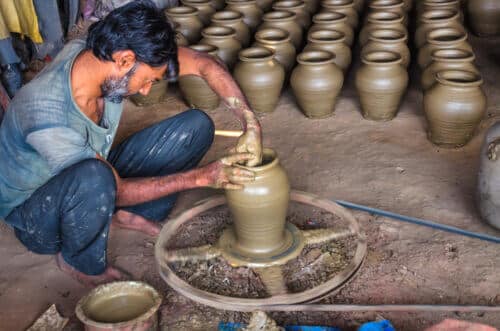Researchers from the Hebrew University examined 300 water jugs in India - and found that ethnic identity and local tradition may influence potters unconsciously, to the extent that they produce hidden "signatures" in standard vessels they produce without realizing it. This has applications from archeology to forensics

In a study recently published in the scientific journal Journal of Anthropological Archeology, and edited by researchers from the Computational Archeology Laboratory at the Institute of Archeology at the Hebrew University of Jerusalem, Approximately 300 jugs produced from the 23s until today, from eight villages in the Jodhpur region of Rajasthan (northwest India), were tested by XNUMX expert potters from two ethnic groups - Muslims and Hindus, two significant religious groups in the country. The jugs, which were apparently produced in the same and uniform way, were digitally photographed and then grouped using 'photogrammetry' technology into a XNUMXD model, and processed in the Computational Archeology Laboratory at the Hebrew University. The overarching goal of the research was to locate cultural and personal "signatures" in the production of standard tools that are similar in shape, made by skilled potters.
The results of the study showed that although both groups apparently produce the same type of jar, each group emphasizes certain tiny geometric features, unconsciously, thus achieving a unique production style. "The potters do not create different products on purpose, they are not even aware that they are making different jars. In fact, their cultural association is stronger than anything, each group produces its products differently and the differences between the tools are so tiny that the human eye is unable to distinguish them. This illustrates their cultural 'fingerprint', of which they are not necessarily aware.", explains one of the study's editors, a doctoral student in the Computational Archeology Laboratory Ortal the hemlock. Furthermore, it was found that the Muslim production network is dense and characterized by strong family ties between villages, while each Hindu village has its own family production network. Therefore, Muslim production makes it difficult to emphasize local morphological 'signatures', in contrast to the Hindu way of production.
The research was conducted in the Laboratory of Computational Archeology at the Institute of Archeology at the Hebrew University of Jerusalem by the doctoral student in the Laboratory of Computational Archeology Ortal Hemlock, Head of the Computational Archeology Laboratory Prof. Lior Grossman, in collaboration with Dr. Valentin Rowe from CNRS in Paris, and the head of the laboratory for documentation and digital research in the archeology of the Antiquities Authority Dr. Avshalom Karsik.
"The application of the method used in this study has important and interesting implications for archaeological research and its interpretation", The researchers further state. "The search for a personal and cultural style in the archaeological record is complex, mainly because archaeological finds do not represent a specific moment in time. The ability to follow minute changes, which are not visible to the eye and can emphasize a personal or cultural 'fingerprint', can be an important contribution in the analysis of the archaeological find."
More of the topic in Hayadan:

4 תגובות
On the one hand, it is written for the general public, on the other hand it is intended for researchers. There are no examples, what it is all about, what it means, how it affects archaeology, what can be learned from this, what is the importance of the research and more. An article that would have been better not published.
Recycling of research that was done quite a few years ago and discovered the same thing, even if with less sophisticated methods. This is a topic that may interest archaeologists but not exactly an item that should go to the media. Apparently, together with the illusory article about the portraits of God in the material figurines that came out not long ago, the Institute of Archeology at the Hebrew University craves a little sensationalism, something that until now was mostly accepted by the competitor from the West.
Can you give an example of a "hidden signature"?
An article speaks in the air and it is impossible to understand - look at some examples
Did the State of Israel finance it?